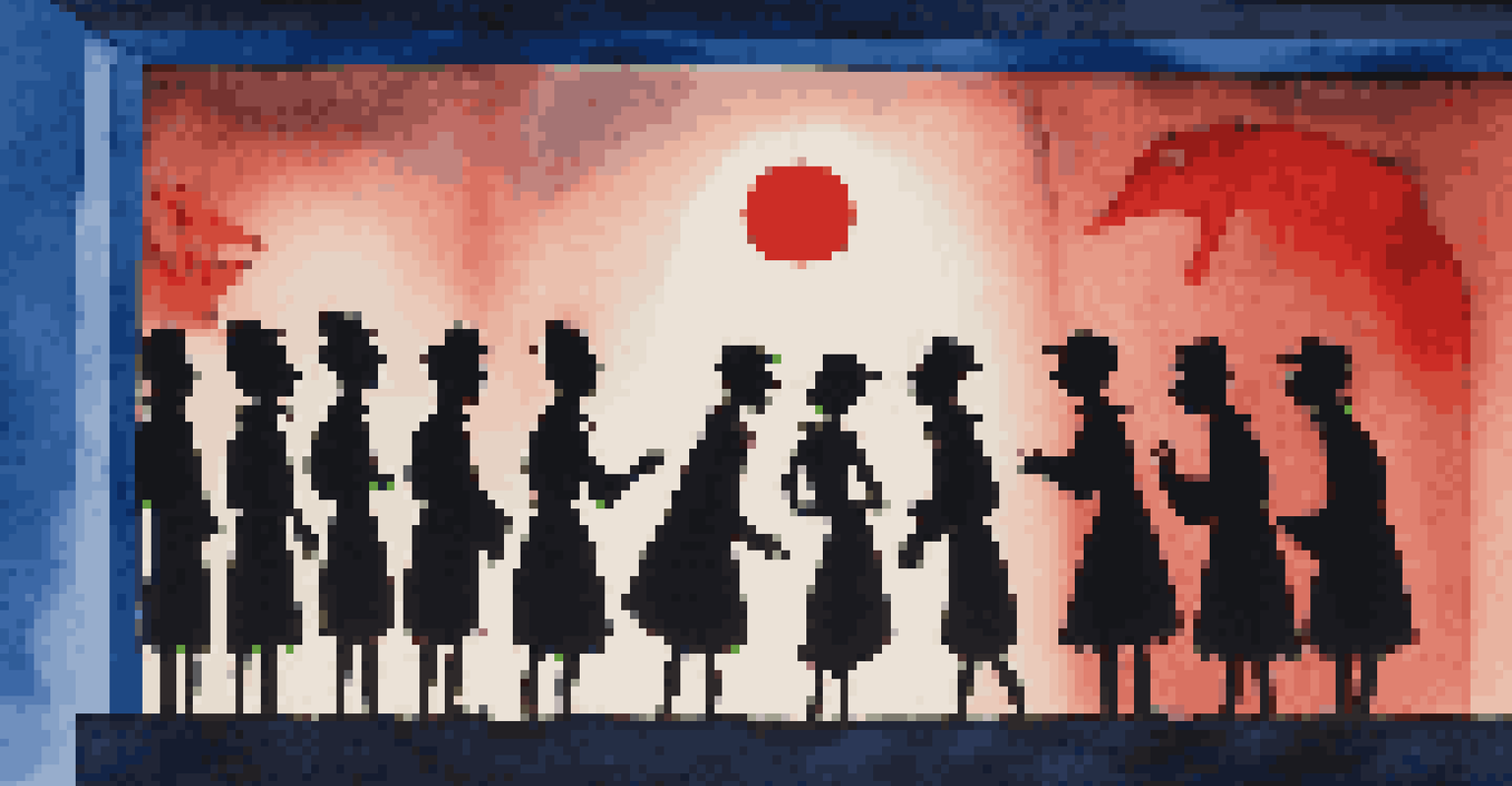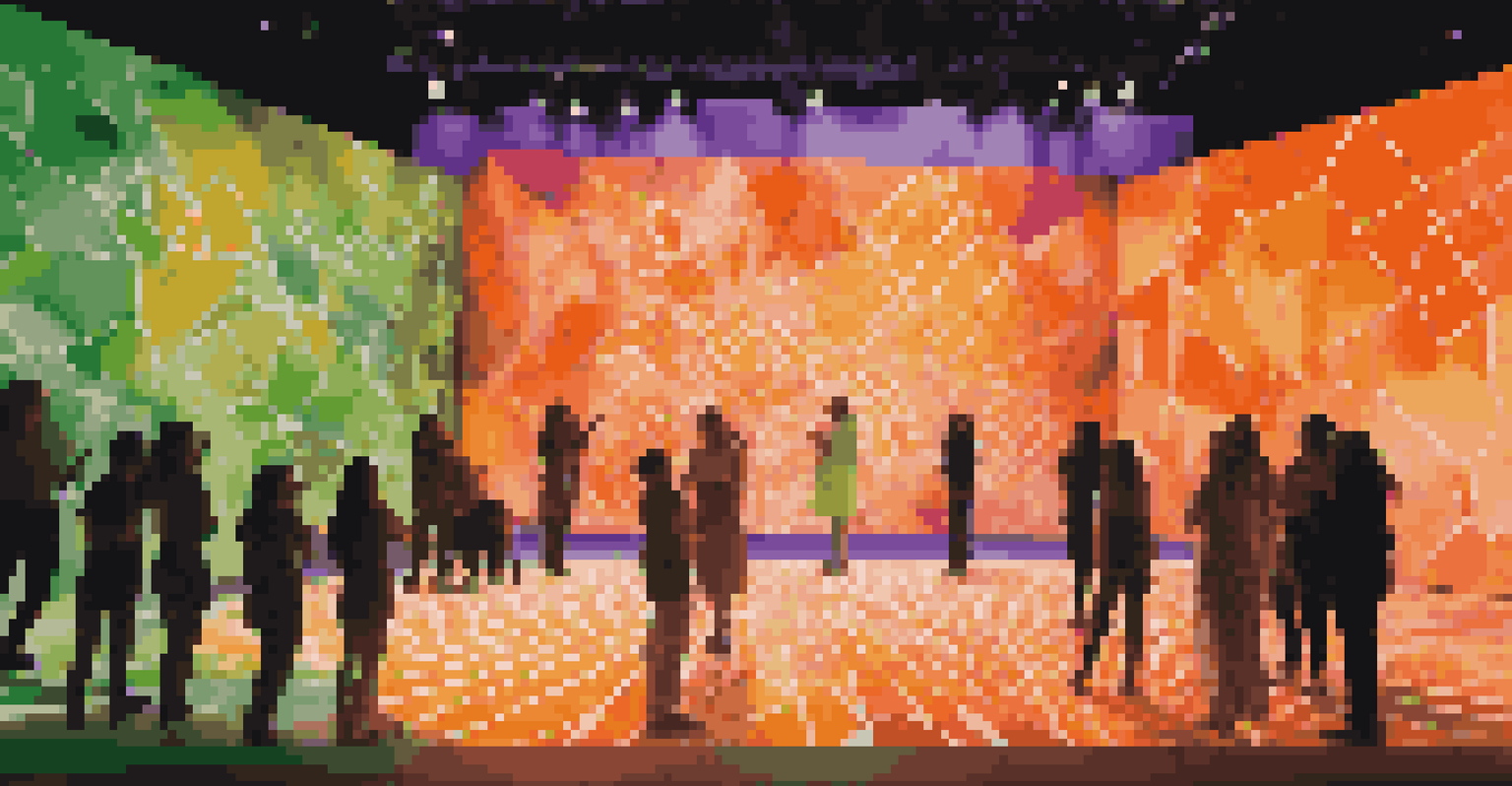The Use of Light and Shadow in Performance Art Productions

The Role of Light in Setting the Mood
Light can transform a simple stage into a world of emotion and atmosphere. By varying intensity and color, artists create moods that resonate deeply with audiences. For instance, a soft, warm light can evoke feelings of nostalgia, while harsh white light may generate tension or unease.
Light is the first element of design; without it, there is no color, texture, or form.
In performance art, these lighting choices aren't just technical; they are integral to storytelling. Consider how a spotlight can isolate a performer, drawing focus to their emotions and actions. This deliberate use of light guides the audience's experience, allowing them to connect more intimately with the narrative.
Moreover, the strategic placement of lights can create a dynamic visual landscape that reflects the performance's themes. By illuminating certain areas while casting others in shadow, artists can symbolize conflict, highlight relationships, or suggest unseen forces at play.
The Power of Shadow in Creating Depth
While light illuminates, shadow adds depth and intrigue to performance art. Shadows can stretch and morph, creating a sense of movement that enhances the overall visual narrative. This interplay between light and shadow invites viewers to explore layers of meaning within a performance.

For example, a dancer's silhouette can tell a story all on its own, as the shadow moves fluidly across the stage, echoing the dancer's actions. This technique not only captivates the audience but also encourages them to interpret the performance in personal ways, fostering a unique connection.
Light Shapes Emotional Atmosphere
The manipulation of light's intensity and color plays a crucial role in evoking emotions and enhancing storytelling in performance art.
Additionally, shadows can serve as a metaphor for the hidden aspects of human experience. By playing with shadow, artists can explore themes of identity, memory, and the subconscious, inviting viewers to confront their own shadows and complexities.
Using Color in Lighting Design
Color in lighting design can evoke specific emotional responses and enhance storytelling. Different colors can symbolize various moods; for instance, blue often conveys sadness, while red can evoke passion or anger. Performance artists leverage this psychological connection to color to deepen audience engagement.
Shadows are the soul of light.
By integrating colored lights, artists can transform the atmosphere of a performance in a matter of moments. A scene bathed in green might suggest a mystical environment, while orange hues can create warmth and comfort. This versatility allows for seamless transitions between different emotional states, keeping the audience captivated.
Furthermore, color can be linked to cultural meanings, adding layers of interpretation. For example, in some cultures, white signifies purity, while in others, it may represent mourning. By incorporating these associations, artists can create performances that resonate on multiple levels, enriching the viewer's experience.
The Interaction Between Performance and Lighting
The relationship between performers and lighting is a dance of its own, where each element influences the other. Performers often adapt their movements based on how they are lit, creating a symbiotic relationship that enhances the visual experience. A well-timed shift in lighting can elevate a moment, making it feel more dramatic or poignant.
Additionally, the performers' physical presence can affect how light is perceived. For instance, the way an actor positions their body can create interesting shadows that add to the narrative. This interaction encourages spontaneity, allowing performances to evolve in real-time, making each show unique.
Shadows Add Depth and Meaning
Shadows enrich performance art by creating depth and inviting viewers to explore complex themes and personal interpretations.
Collaboration between lighting designers and performers is crucial in achieving a cohesive vision. Workshops and rehearsals focused on this interplay can lead to innovative techniques and unexpected discoveries, ultimately enriching the performance art experience.
Shadow Play: A Historical Perspective
Shadow play, an ancient form of storytelling, illustrates the long-standing significance of shadow in performance art. Originating in various cultures, shadow puppetry uses light to cast figures on a screen, captivating audiences with its simplicity and depth. This form of art highlights how shadows can convey complex narratives without spoken words.
Historically, shadow play has served both entertainment and educational purposes, often depicting moral tales or cultural myths. Its ability to blend light and shadow to create engaging stories resonates with contemporary performance art practices. This connection to history enriches modern interpretations and inspires artists to explore new dimensions.
In today's performance art, echoes of shadow play can be seen in various forms, from theater to dance. This lineage emphasizes the power of shadows to communicate, inviting artists to experiment with traditional techniques while crafting their unique narratives.
The Technical Aspects of Lighting Design
Understanding the technical aspects of lighting design is essential for creating effective performance art. Lighting designers must grasp concepts like angle, intensity, and color temperature to manipulate the stage environment. This technical knowledge ensures that the artistic vision translates seamlessly from concept to execution.
For instance, using different types of lights—such as LED, incandescent, or natural light—can drastically change the mood of a performance. Each light source has its own characteristics, influencing how colors appear and how shadows are cast. This attention to detail can significantly enhance the audience's experience.
Tech Innovations Transform Lighting
Emerging technologies like projection mapping are revolutionizing how light and shadow are used in performance art, creating immersive experiences.
Moreover, technology continues to evolve, offering new tools and techniques for lighting design. From programmable lights to automated systems, these innovations can create stunning visual effects that were once unimaginable. As artists embrace these advancements, the possibilities for integrating light and shadow into performance art are expanding.
Future Trends in Light and Shadow in Performance Art
As performance art evolves, so too does the use of light and shadow. Emerging technologies such as projection mapping and interactive lighting are changing the landscape, allowing for more immersive experiences. These innovations invite audiences to engage with the art in new and exciting ways.
For example, projection mapping can turn an entire stage into a dynamic canvas, where images and patterns shift in real-time, complementing the performance. This integration of technology enables artists to tell stories that transcend traditional boundaries, merging visual art with live performance.

Looking ahead, we can expect to see even more experimentation with light and shadow as artists push creative limits. By embracing new media and techniques, performance art will continue to captivate audiences, inviting them to explore the intricate dance between light, shadow, and emotion.